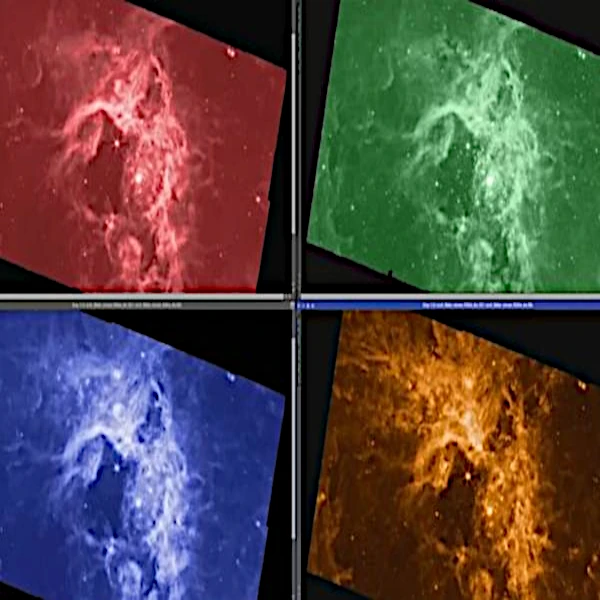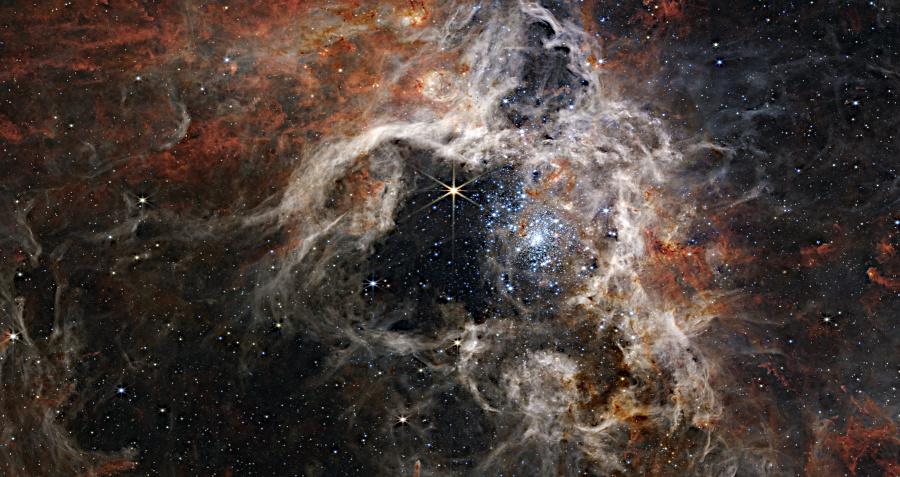
Image: Tarantula nebula NASA's James Webb Space Telescope (Public domain).
JWST takes several successive images of the same celestial object to which it applies infrared filters. Then, these images are reworked by developers into data imaging.
The human eye only sees a very fine part of the light spectrum, from red to violet. But there is light on either side of these two colors. The James Webb Space Telescope (JWST) is designed to observe infrared light, that is, the red side of the visible spectrum.
Using infrared observations, astronomers can detect objects that are not visible in other parts of the electromagnetic spectrum.
Forming stars are often surrounded by clouds of dust and gas. Infrared makes it possible to pierce these clouds and see the stars hidden behind.
Thanks to its infrared cameras (NIRCam, NIRSpec, MIRI, FGS/NIRISS), JWST can also detect very weak thermal emissions from extrasolar planets.
Additionally, due to the expansion of the universe, light emitted by distant objects is red-shifted. As the universe expands, it stretches the wavelengths of light. JWST can observe galaxies that formed more than 13 billion years ago.
Infrared data captured by the instruments is processed and converted into false colors using computer algorithms. The colors do not necessarily correspond to the actual colors of the observed object, but rather to specific features in the infrared spectrum.
To improve the aesthetics of infrared images, data imaging developers must rework them. In other words, these artists transpose infrared light into colors visible to our eyes.
JWST takes several successive images of the same celestial object in the infrared domain, divided into three sub-domains, far infrared (30 µm to 1 mm), mid-infrared (1.5 to 30 µ m) and near infrared '0.75 to 1.5 µm).
The infrared wavelengths are then converted into the colors of the rainbow.
To do this, data imaging developers will respect the data colorization philosophy, called “chromatic order”. Color order is a powerful approach that is used to improve the communication of information. This means that the same colors should be used to represent the same information in different visualizations. Colorful visualizations should be pleasant to look at and understand.
To do this, imaging developers shift infrared wavelengths towards the visible part of the spectrum, so that our eyes can distinguish them. Just like transposing a tune played on the piano into a different key. The pianist changes the pitch of all the notes in the tune, by a constant interval, while preserving the relationships between these notes. In both cases the melody remains the same.
Then the image processing specialists will apply filters. A red filter on the farthest wavelength, a green filter on the middle wavelength, a blue filter on the closest wavelength and a narrow band filter colored in orange.
After superimposing the four filters, they obtain a first colorized image, more interesting but not aesthetically satisfying. This is where human creativity comes into play. Data imaging developers will have to use their subjectivity and artistic sense.
During these different manipulations, the details and quality will gradually improve, always respecting the initial scientific data. In the image, nothing is added and nothing is removed. The objective is, above all, to create a beautiful image to look at.

Image: Tarantula nebula NASA's James Webb Space Telescope (Public domain).
JWST's infrared eye reveals thousands of forming stars like never before. In the Tarantula Nebula we see a stellar nursery (30 Doradus) as well as long dusty filaments, which give its name to the nebula. Tarantula nebula is located in the Large Magellanic Cloud galaxy 160,000 light years from Earth.
In summary, the use of infrared in cosmology provides crucial information about cosmic objects that would not be easily accessible with other observation methods. This opens new perspectives for understanding the formation of stars, exoplanets, galaxies, and the evolution of the entire universe.